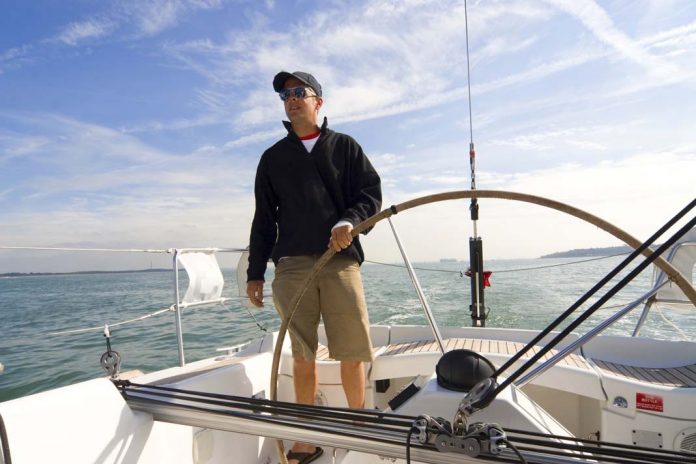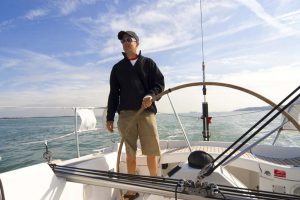

Steering a sailboat fast is the responsibility of the helmsperson.
The rest of the crew takes care of tactics, strategy and sail trim, with the helmsperson concentrating on telltales, instruments and “feel.”
The role of steering is easier when the trimmers communicate with the helmsperson about sail trim, target speeds and so on.
Communication must go both ways. The helmsperson knows how the boat feels, and must constantly let the trimmers know whether the boat feels sluggish, overpowered or “in the groove.”
To steer, you have to turn the boat continually. Some of these course changes are very small, such as when you want to pinch slightly upwind. Other times, like tacking, you have to turn the boat through a large change of course.
There are three ways to make a boat turn:
- Rudder — The disadvantage of the rudder is that it functions as a brake. As soon as you turn it more than a little bit, the water flow separates and the rudder stalls.
- Sails — Using the sails to turn: If you want the bow to head up, trim the main and ease the jib. If you want the bow to head away from the wind, trim the jib and ease the main.
- Heel — When your boat is upright, the underwater profile is symmetrical, and it will go straight. When the boat heels to leeward, the underwater profile becomes asymmetrical, and the water flow makes it head up, producing windward helm. Conversely, windward heel makes the boat head down and produces lee helm.
When you are steering, you should use all three methods no matter how slight your course change, and this will keep the boat going as fast as possible.
Take Account Of the Conditions:
Keep track of everything that’s going on around the boat
- What the waves are doing,
- How fast is the boat going,
- How close to the wind are you heading,
- Your performance compared to other boats,
- Approaching puffs and lulls.
You can’t afford to look at any one of these things alone and have to watch them all at the same time.
SAILING TO WIN BOOK AND BONUSES
Things the helmsperson needs to know:
- Approaching waves and flat spots, and how severe they are.
- Puffs and lulls, and how soon they will hit.
- Changes in wind direction (predicted by using ripples on the water or other boats).
- Pointing and speed relative to other boats
- Meeting with other boats that may require a steering change
- Continual update on genoa and mainsail trim.
Depending on the number in the crew and relevant skill levels, jobs should be given to different crew members. This keeps them involved and spreads the load.
Helm Load
About 3-5 degrees of rudder angle is fastest when sailing to windward.
If there’s too much weather helm, the rudder will create excess drag. Not enough weather helm means that you will lose some or all of your “feel.”
To decrease Helm – flatten the main (and genoa) by tensioning the backstay and outhaul. Move the crew weight outboard and aft and flatten the boat by pinching more and easing the traveller.
To increase Helm – move crew weight to leeward and forward to increase heel. Make the main and genoa more powerful by easing the backstay and outhaul, and add rake to move the sail plan aft.
The lift generated by the rudder helps the keel prevent the boat from sliding to leeward and reduces the leeway angle as well.
The Groove
Being “in the groove” is where the boat feels good and performs well. The goal of the helmsperson is to keep the boat in this groove as much of the time as possible.
You can make the groove wider and easier to find by giving the genoa a wider leading-edge angle and a more draft-forward shape. The disadvantage is that you won’t point as high as possible, and sometimes the windward telltale will seem insensitive to steering changes.
Reduce headstay sag to make a narrower, higher-pointing groove. Remember that the more you flatten out the front of the jib, the more “critical” the sail will become, and the harder it will be to stay in the groove.
Other Steering Tips
- Chop vs. waves – Bear off and power through chop, but steer around waves – up the face and down the back side.
- Light air – Keep the boat moving, or you will lose apparent wind and will have to accelerate again from scratch. The trimmer should communicate with the helmsperson to avoid stalling the boat.
- Medium air – Concentrate on pointing, especially in flat water.
- Heavy air – Note the angle of heel, steer and trim to keep the boat from excessive heel. Take a bite to windward when overpowered. Bear off to sail through big waves and head up in flat spots.
- Tacking – Use weather helm plus crew weight and sail trim in lighter air to let the boat head up slowly into the wind. As soon as the boat is head to wind, give the rudder a harder push to accelerate the turn.

